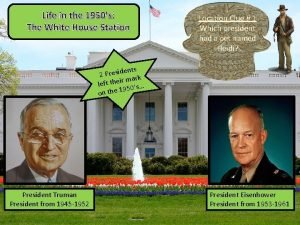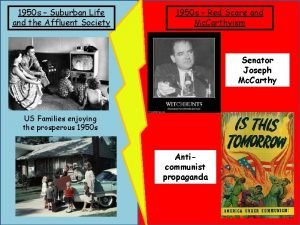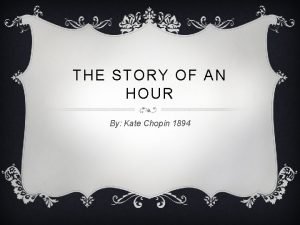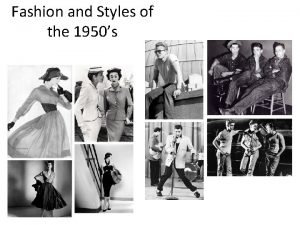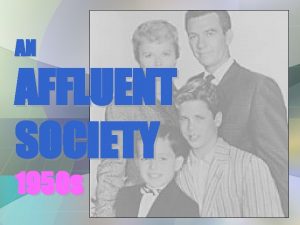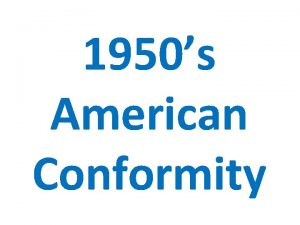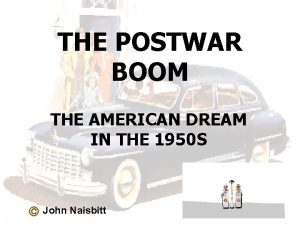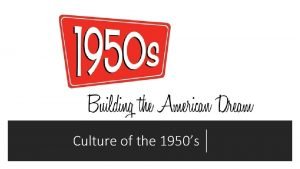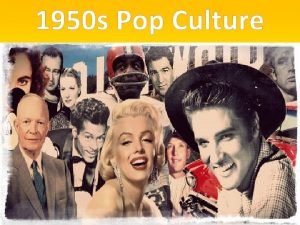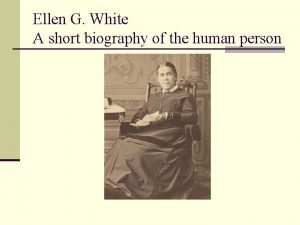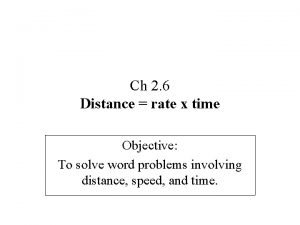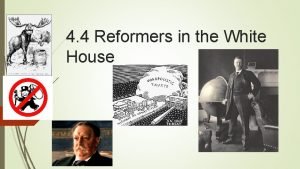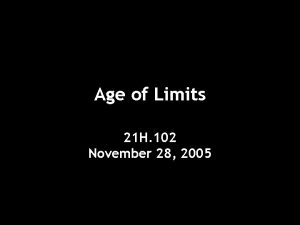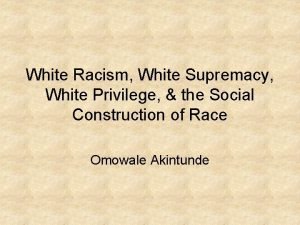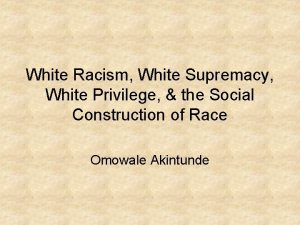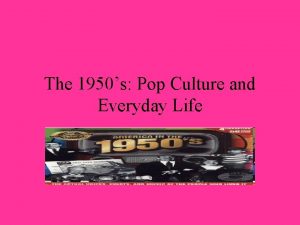Life in the 1950s The White House Station






































- Slides: 38

Life in the 1950’s: The White House Station Location Clue # 1 Which president had a pet named Heidi? ents d i s e r P 2 ark m r i e h t left 50’s… 9 1 e h t on President Truman President from 1945 -1952 President Eisenhower President from 1953 -1961

Life in the 1950’s: The White House Station Do you know the answers? 1) How did Executive Order 9981 affect those serving in the military? Background: Following WWII, in 1948, and the service of many heroic African Americans, I felt that a broad civil rights bill was necessary, but 2) What opposition Congress disagreed. In response I existed against issued an executive order…. Executive Order President Truman’s Executive 9981? Order No. 9981 July 26, 1948 The order stated 3) Is it surprising to that "It is hereby declared to be you, based on the policy of the President that time period, that there shall be equality of there was treatment and opportunity for all opposition? What Staff persons officers from branches protested anonymously and sometimes in theall armed even openly integration. worked with the services withouttoregard to race, The Fahy Committee do you know about discrimination different branches of the military to ensure that the armed forces color, during this time instituted integration their recruitment and unit composition practices. religion, or nationalinorigin. " period? when heavy Full integration did not come until the Korean War however, casualties forced segregated units to merge for survival.

Life in the 1950’s: The White House Station Do you know the answers? 4) Summarize President Eisenhower’s military accomplishments. 5) When did Eisenhower become president? How many terms did he serve? 6) Name 3 things Eisenhower accomplished as the 34 th president. Explain how these 3 events were all related to the Cold War. Scan the QR code or go to History. com http: //www. history. c om/topics/uspresidents/dwight-deisenhower

Life in the 1950’s: The White House Station Background: Under President Eisenhower, America’s national defense policy called for a reduction in conventional armed forces and the buildup of nuclear deterrence capability. The “New Look” defense policy included the development and stockpiling of atomic and hydrogen bombs that would be launched in ‘massive retaliation’ if the United States were attacked. Eisenhower stated, “Our arms must be mighty, ready Year for instant action, so that no potentional aggressor may 1945 be tempted to risk his own 1950 destruction. ” 1955 7) What was the “New Look” defense policy? 8) Why do you think Eisenhower chose to spend more money on a nuclear arsenal instead of conventional forces? U. S. 9) How did the Soviet Union’s development of nuclear weapons Nuclear Warhead Proliferation affect US defense USSR Britainspending? France China 6 0 0 369 5 0 0 0 3. 057 200 10 0 0 1960 20, 434 1, 605 30 0 0 1965 31, 642 6, 129 310 4 1

Location Clue # 2 What was the negative effect on the men of the Lucky Dragon who witnessed the detonation of an American H-Bomb in Bikini Atoll on March 1, 1954? (Look it up!) ack t t a r a Nucle f o n and r o i a n Fe U Soviet minated e h t from m do s i n u ring m u m d o e c r f u o n cult … a c i r e Am 50’s 9 1 e h t

Life in the 1950’s: Nuclear Fear Station Scan the QR Code or go to YOUTUBE and watch “Duck and Cover (1080 p) (Remastered)” Scan the QR Code and watch the first 2 minutes of the video! Or Go to YOUTUBE: How to Protect Yourself from Nuclear Fallout and Survive an Atomic Attack 1950 s Educational Film Photograph: A family sits in their Fallout Shelter; notice the contents of the shelter. Background: In between 1949, when the Soviet Union first tested their own atomic bomb and in 1953 when they tested their first H-Bomb, American fear increased. Would the Soviet Union attack? Americans prepared for an attack at their homes, work places and schools across the country. What preparations were common?

Life in the 1950’s: Nuclear Fear Station Do you know the answers? 3) What were children taught to do in the event of a nuclear bombing? 4) If you were outside when a blast occurs where would you go? 5) What time of the day would a nuclear attack most likely occur? 7) How could a newspaper be used during a nuclear attack? 7) What is fallout? 8) What items were often

Life in the 1950’s: Highway Station Location Clue # 3 What 3, 020 mile long interstate connects Seattle, Washington, with Boston, Massachusetts. ? ber m u n e 0’s th ed cars 5 9 1 e th wn During icans who o he need t er of Am d and so did efficient e se increa ter and mor a for gre utes… ro travel

Life in the 1950’s: Highway Station Do you know the answers? 1) What was the purpose of the video you watched? Why was it made? 2) Why would the government feel that a video of this type needed to be produced? 3) How did the new highway system affect the overall economy? Provide specific examples. 4) What are 5 benefits of Background: On June 29, 1956, President Dwight Eisenhower signed the Federal-Aid Highway Act of 1956. The bill created a 41, 000 -mile “National System of Interstate and Defense Highways” that would, according to Eisenhower, eliminate unsafe roads, inefficient routes, traffic jams and all of the other things that got in the way of “speedy, safe transcontinental travel. ” At the same time, highway advocates argued, “in case of atomic attack on our key cities, the road system would permit quick evacuation of target areas. ” For these reasons, the 1956 law declared that the construction of an elaborate expressway system was “essential to the national interest. ” Scan the QR code or go to YOUTUBE: National Interstate Defense and Highways Act of 1956

Life in the 1950’s: Highway Station

Life in the 1950’s: Highway Station

Life in the 1950’s: Highway Station

Life in the 1950’s: Business Station Location Clue # 4 Who wrote the Affluent Society, claiming that the United States postwar prosperity was a new phenomenon? (last name) Do you know the answers? 1) How was the nature of work changing for men in the 1950’s? 2) What are the 2 factors that contributed to a shift in work from blue collar to white collar work? 3) What is the difference between a franchise and a multinational corporation and explain how Mc. Donalds is an example of both. age r e v a 0, the ughly 6 9 1 d s ro 0 an e 4 i l 9 i 1 m n a f e Betwe f American an working s eg eo incom mericans b te-collar job. A hi tripled d more in w s expanded n es as… e s more a rican busin r e v e nd o and Am e country a th across

Life in the 1950’s: Business Station Document A: Despite later generations’ depiction of the long 1950 s as a stable period, this era was a time of rapid social upheaval for middle-class white males. College educated, suburban living, corporate workers for the first time comprised a significant percentage of the labor population. The new white-collar male came under significant scrutiny from public intellectuals, and corporate work became incompatible with older forms of masculinity. The nineteenth-century ideal of the self-made entrepreneur, and independent farmer was no longer possible because hierarchical corporations emphasized group think and cooperative work and required men to CONFORM to the norm of society. Source: Thomas Andrew Joyce Many Businesses of the 1950’s believed that the “strong personality is viewed with suspicion [and the person] is considered a threat. . ” Document B: Why were there more White-Collar Business Jobs in the 1950’s? William Whyte Jr. What is the explanation for this shift of workers from goods-related to service-related industries? Two factors were of major importance. • Technological improvements and the substitution of machinery for manpower have proceeded much more rapidly in farming, mining, and many types of manufacturing than they have in most of the service-producing industries. It has been both easier and more profitable to mechanize the production of commodities than the production of services. • As personal incomes and leisure time have risen, consumers have greatly increased their demands for many types of services, such as education, medical care, and recreation. Likewise, an increasing proportion of income is being spent for repairs to automobiles, radios, television sets, and other household items; and for advertising, entertainment, and numerous types of activities. It is not surprising, therefore, that the number of white collar workers rose from approximately 22 million in 1950 to 35 million in 1968—a gain of almost 59 percent. In contrast, the number of blue collar workers— craftsmen and foremen, operators of machines and equipment, and lower-skilled nonfarm laborers—in- creased from 23 million to 27 million, or only 18 percent. Within the white collar group, the most rapid rates of increase were among professional and technical workers, whose number rose from less than 5 million in 1950 to over 10 million in 1968, and among clerical workers, whose number increased from under 8 million to almost 13 million. The share of employment represented by the total of professional, technical, and clerical workers rose from 20 to 30 percent of all employees between 1950 and 1968. Source: White Collar, Blue Collar: Job Trends JAMES G. MADDOX

During the 1950 s and 1960 s, American firms of all kinds established offices abroad. Mc. Donalds was an example… opening its first foreign location in British Columbia, Canada, in 1967. According to the U. S. Department of Commerce Bureau of Economic Analysis, the value of American foreign direct investment rose from $12 billion in 1950 to almost $80 billion in 1970. American companies sought to overcome trade barriers such as tariffs erected by most countries around the world that existed in the 1950 s. As trade restrictions eased, however, American companies became more aggressive and tried to link technical, marketing, managerial and financial advantages with cheap overseas labor. During this period, “going multinational” became the fashionable thing to do, and American companies felt a need to develop global product portfolios to remain competitive. With over 30, 000 restaurants operating in more than 100 countries worldwide, Mc. Donald’s is able to serve 52 million customers per day, undoubtedly laying claim to the leading global foodservice retailer. Priding itself on its well-known products, such as the Big Mac and Egg Mc. Muffin, Mc. Donald’s was able to generate 2007 revenues of $22. 8 billion, a record high in the 54 -year history of the fast-food franchise. As a strong competitor in the global market, Mc. Donald’s Corporation constantly faces the test of not only improving its profitability, but also its social and environmental performance. Recently, Mc. Donald’s has embraced the globalization trend that is sweeping multinational corporations all over the world, and is taking large steps in tailoring its products and services to the demands of its local customers…. Document C: The Birth of an American Business in the 1950’s "The 1950 s can be viewed as a time that heralded the franchised restaurant model that is still visible in America today. " What is a franchise? A franchise is a certain company that sells people the same product in different locations. The fast food industry was the most successful out of all of the franchises. Mc. Donald's "Mc. Donald's was one of the first restaurants to become widely franchised in the United States. Though it opened in the 1940 s in California, Ray Kroc, a milkshake mixer salesman, gained permission from the Mc. Donald brothers to franchise the restaurant outside of California in 1954. In just four years, the restaurant had sold over 100 million hamburgers. " Life in the 1950’s: Business Station

Life in the 1950’s: Business Station https: //youtu. be/Ic 5 Inv. M 8 y. QM (You can also access the video at my blog – Current Issues Videos) Do you know the answers? 1) What do the graphs reveal about the American economy from 1950 to 1960? What do the graphs reveal about how Americans were spending their money? 2) Why did the American economy experience a “boom” after WWII? 3) How could returning soldiers use the money provided by the GI Bill? 4) How did the baby boom contribute to economic growth? 5) How did African American unemployment rates compare to the rate of white unemployment? What factors may explain this phenomenon?

Life in the 1950’s: Business Station

Life in the 1950’s: Business Station Do you know the answers? 6) What is ‘the other America’? 7) What groups of people (race, skills) make up the other America? 8) How do the lives of the other Americans differ from the upper classes? 9) What is the irony of urban renewal efforts?

Life in the 1950’s: Suburbia and Consumerism Do you know the answers? 1) Why was mass produced housing in demand after WWII? 2) What did the Levitt Company do to address the housing demand? 3) What was the fastest growing industry during the 1950’s? Why? 4) Describe the advertising of the 1950’s? What methods were used? Who did advertising cater to? Why? Location Clue # 5 What was the location of Levitt and Sons first housing tract?

In 1950, Time Magazine estimated that Levitt and Sons built one out of every 8 houses in United States. Levitt remained the nation’s largest home builder through most of the 1950 s. The first Levittown sprang to life in 1947 on 1200 acres of potato fields on Long Island. To speed production and cut costs, Levitt offered just two basic house types. The scale of the project attracted national attention and made Levitt and Sons a household name. WWII Veterans and their families applied by the thousands to rent and later buy one of Levitt’s mass-produced homes. "Any fool can build homes—what counts is how many you can sell for how little. " William J. Levitt Started in 1929 by attorney Abraham Levitt, Levitt and Sons quickly became one of the nation’s largest home builders. During the 1930 s, the Levitts custom built a few hundred houses a year, mostly on Long Island. In 1941 the firm won a government contract to build 2200 defense housing units in Norfolk, Virginia. It was the Levitts first—but certainly not last —venture in mass housing. "The Henry Ford of Housing" Between 1950 and 1960, 20 million people were drawn to mass housing developments (tract housing) on the outskirts of America's cities. The new suburbs combined country comforts with city conveniences. With the help of modern production and financing methods, builders like Levitt and Sons made the American dream of homeownership affordable to millions. Crabgrass Frontiers LEVITT & SONS AND THE POST WWII HOUSING BOOM Life in the 1950’s: Suburbia and Consumerism

I have come to know that if we sell one house to a Nxxxxx family, then ninety to ninety-five percent of our white customers will not buy into the community. That is their attitude, not ours. We did not create it, and cannot cure it. As a company, our position is simply this: we can solve a housing problem, or we can try to solve a racial problem. But we cannot combine the two. ” It takes people as well as buildings to make a city, and this is a story about the people of Levittown, Pennsylvania. In a sense, it is another interim report on that generation of Americans who came of age while fighting history’s biggest war, then returned to its classrooms to give dubious educators an eyepopping lesson in earnest scholarship while, simultaneously, it began raising bumper baby crops…. By mid-1954 at prices ranging from $8990 to $16, 500, some 9000 houses had been built, sold and occupied… Within Levittown, many residents say, the atmosphere is more tolerant and neighborly than any other place they ever lived. However, Levittowners collectively have not yet come to grips with one problem that could give rise to a really tense situation. This is the problem of Nxxxx exclusion. The Levitts do not sell their houses to Nxxxx. This, as William Levitt explains it, is not a matter of prejudice, but one of business. Excerpt from “Growing Pains of a Brand-New City” By Craig Thompson Saturday Evening Post August 7, 1954 Life in the 1950’s: Suburbia and Consumerism

Life in the 1950’s: Suburbia and Consumerism Background: The conformity of the 1950’s included American’s desires to own the same new products and labor- saving appliances as their neighbors. Spurring this trend was an improvement in advertising. Advertising became the fastest growing industry in the USA and advertisers were very successful using new marketing techniques to sell products. At the same time, the first credit cards allowed consumers to use credit at any and all stores.

Life in the 1950’s: Suburbia and Consumerism

Life in the 1950’s: Suburbia and Consumerism Do you know the answers? 5) How did Levittowns contribute to racial segregation of neighborhoods? 6) Levitt’s refusal to sell homes to African-Americans is a practice called ‘redlining’? What are the consequences of ‘redlining’? 7) What are the negative consequences of consumerism?

Welcome to the Life in the 1950’s: Role of Women Station Location Clue # 6 Who wrote a book about the struggles of housewives called “The Feminine Mystique”? (last name)

Life in the 1950’s: Role of Women Station Background: Almost exactly nine months after World War II ended, “the cry of the baby was heard across the land, ” as historian Landon Jones later described the trend. More babies were born in 1946 than ever before: 3. 4 million, 20 percent more than in 1945. This was the beginning of the so-called “baby boom. ” In 1947, another 3. 8 million babies were born; 3. 9 million were born in 1952; and more than 4 million were born every year from 1954 until 1964, when the boom finally tapered off. By then, there were 76. 4 million “baby boomers” in the United States. (History. Com)

Life in the 1950’s: Role of Women Station Scan the QR code or go to YOUTUBE: 1950 s women to watch the video. Do you know the answers? 1) What happened to the birthrate during the 1950’s? Use bar graph to be specific. 2) Why was the birthrate higher in the late 40’s into the 50’s? 3) According to the graph, what were the Marriage and Divorce rates in the 1950’s? What conclusions can you draw about what was “expected’ of women in the 1950’s? 4) According to the video clip, what role did women have in the home? How did women feel about this role? How might the role of women during WWII effect their feelings about their change of role in the 50’s?

Life in the 1950’s: Role of Women Station Background: In October 1949, a new Army regulation required that active duty servicewomen with children to be discharged from military service. The following testimony was provided by Mrs. Anna Gordon, a Reservist in the WAVES. Mr. Chairman and honorable members of the Senate Armed Forces Committee, I would like to state that I am appearing at no expense to the Government, because I am here as a citizen exercising the duties and privileges of citizenship, and I prefer to be introduced as Mrs. Gordon, as an observer holding a Reserve commission in the WAVES appearing before you today, which gives me an opportunity of stating my convictions not only as to what is right and fair but also as to what is in the best interest of the services. First of all, it would seem to me that forcing the resignation of women with minor children is in this day and age an anachronism. The choice between marriage or a career or children or a career is no longer a problem. A woman who has spent years in preparation for a career and has a living interest in what she is doing does not nowadays give it up with a sigh of resignation when she is preparing for the role of motherhood; nor does she usually give up thoughts of motherhood for a career; the modern woman finds that both are compatible, except for a temporary withdrawal from professional life-and I think we have heard how temporary sometimes that may be.

Life in the 1950’s: Technology Station Location Clue # 7 What invention revolutionized how people paid for food and began with the Diners’Club?

Life in the 1950’s: Technology Station Source A Scan the QR code or go to History. com and watch “ 1950’s” http: //www. history. com/topics /1950 s/videos

Life in the 1950’s: Technology Station LLENGED PREVAILING SCIENTIFIC ORTHODOXY IN HIS VACCINE MENT. st scientists believed that effective vaccines could only be developed with s, Salk developed a “killed-virus” vaccine by growing samples of the virus deactivating them by adding formaldehyde so that they could no longer . By injecting the benign strains into the bloodstream, the vaccine tricked ne system into manufacturing protective antibodies without the need to a weakened form of the virus into healthy patients. TED THE VACCINE ON HIMSELF AND HIS FAMILY. essfully inoculating thousands of monkeys, Salk began the risky step of e vaccine on humans in 1952. In addition to administering the vaccine to t two Pittsburgh-area institutions, Salk injected himself, his wife and his three s kitchen after boiling the needles and syringes on his stovetop. Salk d the success of the initial human tests to a national radio audience on 1953. ICAL TRIAL WAS THE BIGGEST PUBLIC HEALTH EXPERIMENT IN N HISTORY. 6, 1954, six-year-old Randy Kerr was injected with the Salk vaccine at the herman Elementary School in Mc. Lean, Virginia. By the end of June, an nted 1. 8 million people, including hundreds of thousands of schoolchildren, in becoming “polio pioneers. ” For the first time, researchers used the ind method, now standard, in which neither the patient nor person ring the inoculation knew if it was a vaccine or placebo. NOT PATENT HIS VACCINE. 2, 1955, the day the Salk vaccine was declared “safe, effective and potent, ” CBS newsman Edward R. Morrow interviewed its creator and asked who e patent. “Well, the people, I would say, ” said Salk in light of the millions of donations raised by the March of Dimes that funded the vaccine’s research esting. “There is no patent. Could you patent the sun? ” Lawyers for the n had investigated the possibility of patenting the vaccine but did not in part because of Salk’s reluctance. H A TAINTED BATCH OF THE SALK VACCINE KILLED 11 PEOPLE, NS CONTINUED VACCINATING THEIR CHILDREN. s after the Salk vaccine had been declared safe, more than 200 polio cases d to lots contaminated with virulent live polio strains manufactured by the oratories in Berkeley, California. Most taken ill became severely paralyzed. d. In the haste to rush the vaccine to the public, the federal government had ed proper supervision of the major drug companies contracted by the Dimes to produce 9 million doses of vaccine for 1955. Although the United geon general ordered all inoculations temporarily halted, Americans to vaccinate themselves and their children. Outside of the “Cutter not a single case of polio attributed to the Salk vaccine was ever contracted States. ACCINE SUPPLANTED SALK’S IN THE 1960 S. in’s oral vaccine finally became available in 1962, it quickly supplanted jected vaccine because it was cheaper to produce and easier to administer. , both vaccines produced by the bitter rivals nearly eradicated the disease lanet. According to the World Health Organization (WHO), there were only ted cases of polio worldwide in 2013, mostly confined to a handful of Asian YOU MAY NOT KNOW ABOUT JONAS SALK AND THE POLIO VACCINE-

Life in the 1950’s: Technology Station Source B Do you know the answers? The Soviet Union begins the “Space Age” with its launch of Sputnik, the world’s first artificial satellite. The spacecraft, named Sputnik after the Russian word for “satellite, ” was launched at 10: 29 p. m. Moscow time from the Tyuratam launch base in the Kazakh Republic. Sputnik had a diameter of 22 inches and weighed 184 pounds and circled Earth once every hour and 36 minutes. Source: History. com 1) What are 4 inventions that are mentioned in both the video and the exhibit. (Source A) 2) What was unique about Jonas Salk’s polio vaccine? 3) Why did Salk never patent his vaccine and what was the result of that decision? 4) According to Source B, what was America’s reaction to the Soviet Union’s launch of Sputnik? 5) According to the advertising above, how were televisions marketed to American families in the 1950’s?

Location Clue # 8 The 1950’s helped to create a cultural separation between children and parents known as what? Life in the 1950’s: Popular Culture Station Do you know the answers? 1) What percentage of Americans owned a TV in 1950 versus 1960? 2) What 2 new concepts were introduced by the TV? 3) Why were critics concerned about popular TV shows like “I Love Lucy”, Gunsmoke, and the Honeymooners? 4) Parents felt that Rock n’ Roll and the “Beat Movement” encouraged their teenagers to do what? 5) Cars were necessary in the 1950’s for what 3 reasons? 6) Cars added what 3 concepts to American culture? 7) What characterized the “teenage” life in the 1950’s?

Life in the 1950’s: Popular Culture Station Scan the QR code or go to YOUTUBE: Objective 7. 6 Fifties Pop Culture to watch video. Video posted by You Will Love History

Life in the 1950’s: Poverty Station Do you know the answers? 1) What groups were experiencing poverty in the 1950’s? 2) Where did most of these groups go to escape the poverty they were experiencing? 3) In 1959, what was the percentage of families that lived in poverty? 4) What is one distinct quality of poverty that is the same in the 21 st century as it was in 1959? Location Clue # 9 Who wrote the book, The Other America in which the author wrote about the rundown hidden communities of the country? (last name)

Life in the 1950’s: Poverty Station Despite the growing economy and affluence of 1950’s America, 1 out of every 3 Americans were living below the poverty line. Who were the poor? Native Americans Appalachia African Americans Hispanics In the 1950’s, Native Americans who returned safely from war now faced a new challenge, the Termination policy. Under this policy the Federal government withdrew all official recognition of Native groups and made them subject to the same laws as white citizens. Many left reservations to seek work in cities forcing them to live in crowded housing to afford life in the city. Whites in the mountains of Appalachia also moved to cities seeking work in the 1950’s, abandoning elderly and less mobile relatives. A host of statistics showed that life in Appalachia including high infant mortality rates and high rates of nutritional deficiency were rampant. More then 3 million African Americans fled North from the South between 19401960. However, many found that discrimination and unemployment were realities of life in the North as well as the South. African Americans were the last hired and the first fired and made on average only 51% of the salary earned by whites. During the 1950’s and 1960’s the Bracero Program brought nearly 5 million Mexicans to the USA to work on farms and ranches in the Southwest. These laborers lived a life of extreme poverty and hardship, toiling long hours for little pay.

Introduction: The Paradox of Poverty in American society is based on paradoxes. Its citizens are at once among the richest and the most economically insecure in the developed world. While income inequality was once on the decline, over the last twenty years the distribution of wealth and prosperity in the nation has become more unequal. Individuals and families at greatest risk for poverty are men with less than a college education, people of color (especially blacks and Hispanics), working families and families headed by women, and a significant number of the nation’s elderly, who live at or close to the poverty line. A reflection on late 1950 s America reveals a nation poised to embrace a vision of opportunity shared by all. It is a reflection we begin with to tell the story of America today. America is not the nation it envisioned itself being four decades ago. In the land of opportunity, many of its citizens experience poverty, economic insecurity, and income inequality on a daily basis. The Demography of Poverty: Starting in the 1950 s In 1959, according to federal poverty statistics, at least 20. 8% of families lived in poverty (Table 3). While 16. 5% of white families lived below the poverty line, 54. 9% of black families were poor. One out of two female-headed households lived below the poverty line. Two thirds of black female-headed households lived in poverty. More than one in four children lived below the poverty line in 1959 regardless of whether the family was headed by a male or female (Table 4). Rates were significantly higher for children of color compared with white children (39. 6% versus 11. 0%). It was not until 1972 that the federal government published poverty statistics for Hispanic families, too, had high rates of poverty— 22. 3% in the early 1970 s. Almost one third of Hispanic children also were poor (Table 5). The Geography of Poverty In the first half of the 20 th century, poverty was primarily confined to rural areas. In 1959, while 18. 3% of central city residents lived below the poverty line, 33. 2% of non-metro residents were classified as poor (Figure 9). Regional data show that in the 1960 s, the poor were concentrated in the South—the location of 46% of the nation’s poverty population (Map 4). The relatively unsettled West had the lowest poverty share (15%), followed by the Northeast (17%) and the Midwest (22%). Looking back to 1960, the poor were concentrated in Appalachia, the Mississippi Delta, the U. S. -Mexico border, Indian reservations, the Upper Peninsula, and the Atlantic Sea Coast (Map 5). Poverty Forty Years Later: What Progress Has Been Made? Despite a four-fold nominal increase in median family income over the last forty years, the absolute number of people in poverty has changed remarkably little in four decades (Figure 10). The lack of decline in the absolute number of persons in poverty is correlated with several factors. One that is clearly important is the stagnation of real median family incomes (1959 adjusted family income was $60, 670 versus $43, 318 in 2003). Another distinct quality of poverty in the nation is its persistence. In 2003, as in 1959, a person of color was far more likely than a white person to be living below the poverty line. A person of color still had a one in four chance of being poor. For whites it was one in ten. Source: http: //povertyinamerica. mit. edu/download/atlas_of_poverty_in_america_p 1. pdf

Source: http: //povertyinamerica. mit. edu/download/atlas_of_poverty_in_america_p 1. pdf
 White house 1950s
White house 1950s Suburban life 1950s
Suburban life 1950s Pop culture of the 1950s
Pop culture of the 1950s White mountain research
White mountain research 1950s home economics textbook
1950s home economics textbook Computers in the 1950
Computers in the 1950 1950s fashin
1950s fashin Concept cars 1950s
Concept cars 1950s The affluent society 1950s
The affluent society 1950s 50s music trivia questions and answers
50s music trivia questions and answers Challenges to the mass conformity of the 1950s came from
Challenges to the mass conformity of the 1950s came from 1950s conformity and counterculture
1950s conformity and counterculture How were conglomerates and franchises alike and different
How were conglomerates and franchises alike and different Cost of living 1958
Cost of living 1958 Mass media 1950s
Mass media 1950s Beat writers 1950s
Beat writers 1950s 1950s beatnik fashion
1950s beatnik fashion Education in the 50s
Education in the 50s Wwii show
Wwii show Trends of 1950s
Trends of 1950s Trends of 1950s
Trends of 1950s Trends of 1950s
Trends of 1950s Trends of 1950s
Trends of 1950s Trends of 1950s
Trends of 1950s Red scare 1950s
Red scare 1950s Nonsense poem
Nonsense poem Ellen g. white henry nichols white
Ellen g. white henry nichols white What is the green room in the white house
What is the green room in the white house Brainpop voting
Brainpop voting Reformers in the white house
Reformers in the white house White house farm ingleby barwick
White house farm ingleby barwick White house ground floor
White house ground floor The white house
The white house America comes of age lesson 4 reformers in the white house
America comes of age lesson 4 reformers in the white house The white house
The white house 4 1/2 cent white house stamp
4 1/2 cent white house stamp Nixon leaving white house
Nixon leaving white house Woodrow the white house mouse
Woodrow the white house mouse Dr dalton benson
Dr dalton benson
